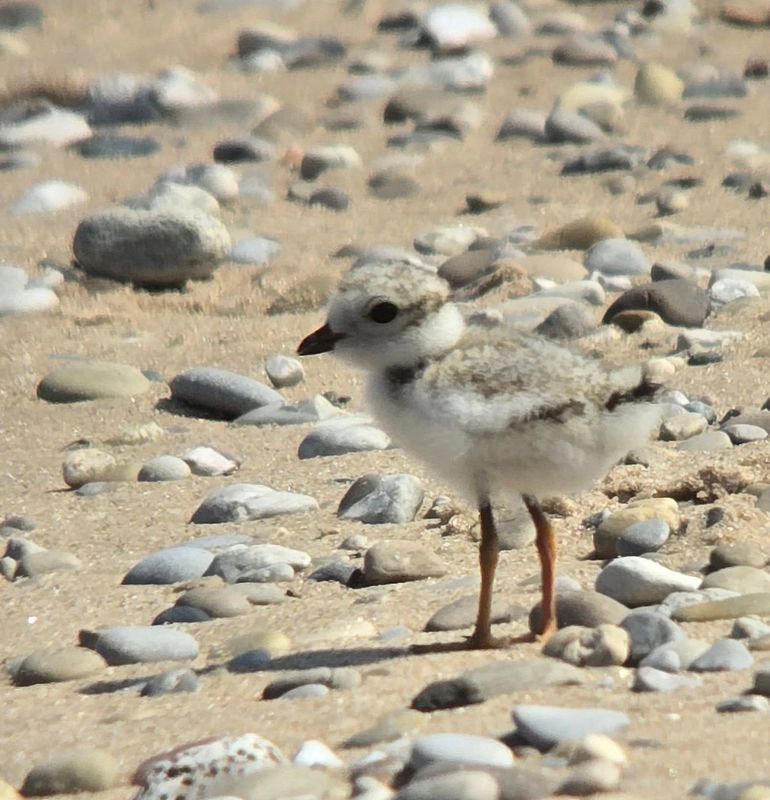One of the oldest-known endangered piping plovers at Sleeping Bear National Lakeshore increased her impressive breeding record this summer, adding two more chicks to her lineage, the park announced on social media.
“While famed for her old age, she has also been an excellent mother. Prior to this season, Gabby fledged 35 chicks over her previous breeding seasons. Exciting news is that Gabby has added two more to her line!,” the park said in a Facebook post.
At 16 years old, the Great Lakes piping plover, officially designated “Of,gb:X,Y,” is the oldest ever recorded for the lakeshore’s endangered piping plover population.
“She is often referred to as ‘Gabby’ in reference to the gby from her unique color band combination,” the park said in the post.
The U.S. Fish & Wildlife Service says most piping plovers have been documented to live up to 11 years with the average life span approximately five to six years.
This week, Gabby’s two chicks — she laid four eggs, but only two hatched — reached “fledging age,” the park said, the age at which they can fly and take care of themselves.
The 37 chicks fledged in her lifetime is thought to be near a record for an individual piping plover as well, the park said.
“While summer is just reaching its peak here in northern Michigan, for female piping plovers the season is winding down,” the park said. “Many female Great Lakes piping plovers begin their fall migrations as early as mid-July. In a couple weeks Gabby will leave Sleeping Bear Dunes and begin her annual migration to Georgia.
“Gabby’s chicks are likely to stay a little longer,” the park added. “Chicks often stay near their male parent until the end of July or early August before beginning their southbound migrations.”
Gabby winters at Cumberland Island National Seashore in Georgia, just north of the Florida state line on the Atlantic coast.
What to know about plovers.
What is a piping plover?
The piping plover (Charadrius melodus) is a small migratory shorebird that nests and feeds along coastal sand and gravel beaches in North America, the U.S. Fish and Wildlife Service said. There are three populations of piping plover: subspecies C. m. circumcinctus that has one population that occurs on the shorelines of the Great Lakes, and another population that occurs along the rivers and lakes in the Northern Great Plains. Another subspecies, C. m. melodus, occurs along the Atlantic Coast.
Adult birds are about 7 inches long — robin-sized, according to Michigan State University — with a wingspan of 15 inches. They weigh up to 2.3 ounces. Piping plovers are sandy grayish brown in color and have white underparts, as described by Cornell University in 2019. Adult breeding plumage includes a single black breast band, which is often incomplete, and a black bar across the forehead.
The small birds hunt on sandy mud flats, ephemeral pools and seasonally emergent seagrass beds with abundant invertebrates, the USFWS said.
Are the birds endangered?
In 1985, the Atlantic Coast and Northern Great Plains populations were listed as threatened, and the population in the Great Lakes watershed was listed as endangered.
Habitat destruction, habitat alteration and human development of shorelines has resulted in the extirpation of Piping plovers from most formerly occupied Great Lakes states, MSU said.
Human interference — use of motorized vehicles on the beach, beach walking, bike riding, kite flying, fireworks, bonfires, horseback riding, and camping — have been observed to disturb plovers and disrupt normal behavior, MSU added.
How do they track plovers?
The USFWS and other researchers band plovers to track their movements and learn about them.
If you spot a banded plover, officials ask the public to report it via email. The most important information is about the bands on the birds: their color, shape, and location on the bird’s legs.
Where do the birds nest?
Habitat for the plover consists of wide, flat, open, sandy beaches with sparse vegetation and scattered stones, MSU says. Nesting territories often include a variety of micro-habitats such as seeps, interdunal wetlands, and small creeks.
Piping plovers start arriving on breeding grounds in early April, followed by courtship and nesting in mid-to-late April, the USFWS said. Male plovers create a shallow depression on the ground which both adults line with small pebbles. Eggs incubate up to 28 days. Eggs hatch between late May and early June.
Where to find plovers in Michigan
MSU says birds have been seen nesting throughout the eastern UP, as well as nearly all of Michigan’s west coast. The birds have been spotted all around Saginaw Bay and north along Lake Huron.
How you can help plovers survive in Michigan
Sleeping Bear National Lakeshore offered tips for protecting the small birds:
This article originally appeared on Lansing State Journal: Sleeping Bear Lakeshore plover welcomes 37th chick. Why that makes ‘Gabby’ a record-setter
Reporting by Dan Basso, Lansing State Journal / Lansing State Journal
USA TODAY Network via Reuters Connect


